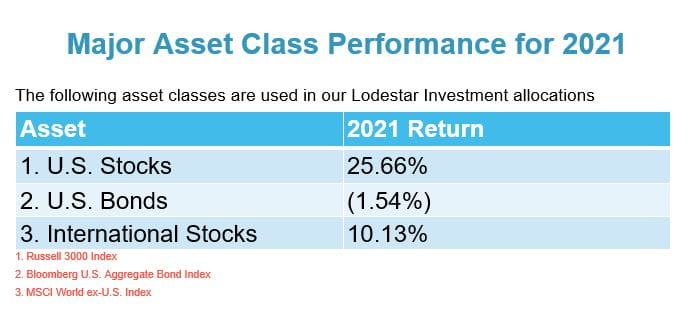I'ts 2022 and the capital markets are still beating to their own drum

The calendar becomes outdated once per year but the capital markets (stock and bond investments) teach us lessons that have remained consistent over time.
- Prices are ultimately driven by earnings, not headlines.
- There are no reliable future price movement indicators.
- Price declines are frequent and normal.
- Capital markets have demonstrated to be resilient, even during major events.
- Publicly traded companies have shown effectiveness at overcoming obstacles. 6. Each past broad stock market decline throughout history has been temporary.

The beginning of a new year is a good time to review past lessons. Lessons can be taught theoretically or by experience. Theoretical is less emotional because it's purely academic. As it pertains to capital market investing, learning a lesson through experience often involves emotions. The first time your in-
vestment portfolio declines 10% or more in value you have received a valuable lesson in volatility, likely an unpleasant one. If that lesson was prefaced by the understanding it was inevitable then it should be an expected event and not a surprise. A surprise is much more likely to trigger negative emotions than an expected event. In my experience, investors who maintain reasonable expectations are less likely to make costly mistakes when faced with inevitable price declines. For this reason, I have made a habit of reminding investors, even experienced ones, that while the capital markets are unpredictable in the short term there are many patterns that have been consistent over time. These patterns have become great lessons and are used to establish reasonable expectations.
Let's review each of the six lessons above.
A major news outlet posted the following financial related headline this morning, Dow futures drop 300 points as rates rise. For investors, I believe this headline is useless. You can find similar headlines every trading day. It seems to be the duty of these organizations to link price movement to a current event regardless of actual correlation. Market prices are determined by the aggregate views of millions of buyers and sellers which makes attaching any single event to current price movement an exercise in futility. (For those who saw the headline above and are concerned about the impact of rising interest rates on stock prices, the following link is to an article I wrote in 2015 on this subject. https://www.raymondjames.com/odellandassociates/capital-markets-university/2015/12/23/monetary-policy-and-stock-market-returns.) An important thing to remember when reading such headlines is this; broad U.S. stock prices have shown a 97% correlation to broad U.S. stock earnings over long periods of time[1]. A major event may distract that relationship, temporarily, but history shows the focus shall appropriately return to earnings.
Since earnings are most important to future price movement, prognosticators look for clues to forecast future earnings. In other words, they try to predict future price movements. How many "experts" do you recall accurately predicted broad stock market price returns in 2021? Anyone? Almost all I'm aware of predicted doom for 2021. It's hard to fault that type of forecast when in the midst of a global pandemic, experiencing a historically unprecedented rise in inflation, the national supply chain suffers major disruption and many retail businesses are dealing with employee shortages. Unless, of course, you are a student of the capital markets and understand how resilient companies can be. I don't believe there are any reliable future price movement indicators and I don't feel they are necessary. With a decline in uncertainty comes a similar decline in potential return. Uncertainty is the catalyst for the historical premium in stock market returns.
Stock market price declines are frequent and normal. The average intra-year decline for broad U.S. stock prices is about 14%[2]. This means we can expect a significant temporary decline, each and every year. That's an average, which means some years it will be much higher and others much lower. Since 1980, the broad U.S. stock market has ended the year with a positive return 32 out of the 42 year period[3]. Nearly one of four years ended in a negative return. Once again the lesson has turned into an expectation, one in four years (25% of the time) expect to have a negative annual return.
I won't belabor the point of broad stock market price resiliency, nothing I could write would offer more validity than the remarkable performance in 2020 and 2021, two headline heavy years. One thing I will add is that deteriorating earnings is unsustainable. Companies are well aware that they must overcome whatever obstacles (government, global, social, political, etc) that are placed in their path. They don't have the luxury of sitting back and waiting for things to improve. As a group, they have demonstrated resiliency and capabilities over long periods of time.
Since 1926, broad U.S. stock prices have been steadily increasing while experiencing temporary declines[4]. Nobody can tell us what the future holds but what I do know is that we all have a need to be financially stable and based on my personal experience, I believe the capital markets continue to be an appropriate tool to utilize towards that end.
Our in house investment management, Lodestar, utilize these three asset classes to achieve diversity. Each of these asset classes come with a long track record that we use to determine expectations and assign financial objectives. Lodestar consists of six investment objectives (Conservative, Conservative Balanced, Balanced, Balanced Growth, Growth and Aggressive). The objective assigned to an account is based on client goals rather than risk tolerance. Many advisory firms use risk tolerance questionnaires to determine asset allocation and we disagree with that methodology. Risk tolerance can change throughout market cycles, leading investors to make frequent investment changes. Selling stock positions during a significant decline has historically led to unrecoverable losses. Client long-term goals and objectives are much more stable and tend not to change with stock price movements. Changes to investment allocation and/or strategy should only occur as a result of a change in long term financial goals.
Many of you are already aware that we, as part of standard practice, rebalance the Lodestar Investment allocations in January. Rebalancing is a discipline, not a strategy, designed to prevent risk creep and to maintain the assigned investment asset allocation with a determined client goal. A quick and easy explanation of rebalancing is to understand that some asset classes outpace others in performance over time. As an example, stocks have historically delivered higher returns than bonds. If an investor were to invest today in a 60% stock and 40% bond (60/40) allocation, it is likely over time (without periodic rebalancing) the stock percentage would increase and your allocation would organically change. We call this "risk creep" because the higher volatility asset class percentage is slowly increasing while the lower volatility asset class is decreasing. A periodic rebalance simply returns the allocation to the original 60/40 target. In addition to our standard rebalance in January, we may implement a rebalance in times of significant market declines (as we did in March and April 2020). During these events we liquidate enough of the bond position to return the stock allocation back to the target weighting. This is possible by reinvesting the bond liquidation proceeds into stocks. Because of the guidelines and criteria we have in place, this also is a discipline and not an attempt to time market prices.
As typical, I will wrap up this year's first article without any predictions. In my opinion, predictions (outlooks, forecasts, etc.) are not actionable. I'll leave it to those who get paid to publish such things. Our job is to do our very best to help you create a plan designed to achieve your most important financial goals and to create appropriate, academic based investment allocations to accompany those goals.
As always, we appreciate your trust and confidence and look forward to another year serving your financial needs.
Best wishes for many blessings in 2022!
Rick
Rick O'Dell, AAMS
President, OCM, Inc.
Registered Principal, RJFS, Inc.


